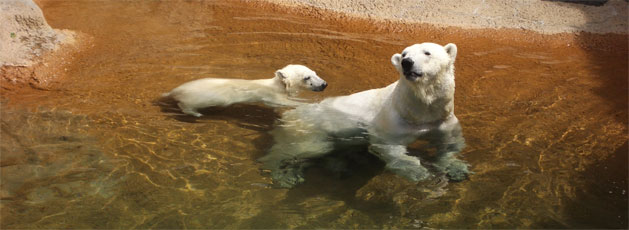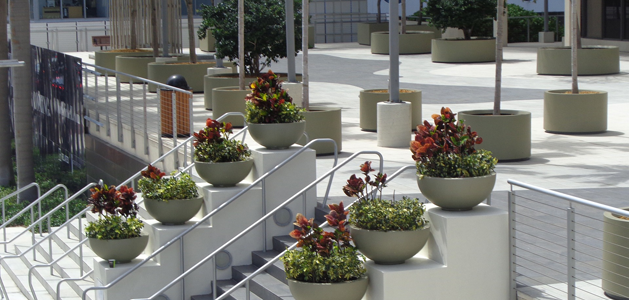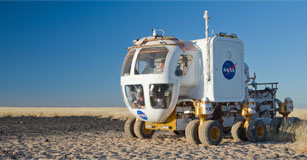Design a Polar Park
Students design enclosures for animals that live in the Arctic or Antarctic regions, reflecting the animal’s natural habitat, as well as its air, water, food, shelter, and activity needs.

Task
When zoos and aquariums design animal enclosures, they make sure they are both safe and interactive for the animals. They also work hard to ensure the enclosure reflects the animal’s natural habitat.
In this project, your class will work together to design a Polar Park with a variety of exhibits that showcase the animals in the Arctic or Antarctic region. It is your task to design an enclosure for a specific animal that considers the survival needs of the animal, accurately reflects their natural habitat, and helps visitors learn more about this unique species.
Engage
Begin by engaging your students in discussions about weather, climate, and animal adaptations.
Ask your students what type of weather they prefer. Do they prefer summer where the weather is warm, or winter where they bundle up to play in the snow? Ask students to explain how they do different things in different seasons and how their behavior (food, clothing, activities) changes when the temperature changes.
Ask your students which season, or weather (climate), they think animals prefer. It may take a little prompting, but students should soon see that different animals may have different preferences. Ask them to explain and elaborate using specific animals, and their characteristics, as examples.
Read a book such as Polar Bears or Penguins by Gail Gibbons. Discuss the unique adaptations and characteristics of polar animals. Discuss how the environment in which these animals live compares to the environment in which your students live.
Next, ask students if they have ever visited a zoo or an aquarium. What was their favorite exhibit? Why? What specific features made it memorable? What do they think the animals in the enclosure felt about the exhibits?
Show students a picture of a penguin in their natural habitat.

Ask the students to describe what they see in the habitat. Which of those features could be replicated in a zoo exhibit?
Let the students know that your class will be designing a Polar Park. As a class, decide if you will focus on Arctic or Antarctic animals or if you will mix animals (but label or group them) from both regions.
Form small teams of students to design an enclosure for a specific animal. Since the focus of this project is on habitat and requirements for life, let students choose to make their exhibit any size and using any budget/materials.
Have teams begin by researching their animal. They should be encouraged to become an expert on this animal, its unique characteristics, and needs. Provide them with graphic organizers, such as clusters, to keep notes on plants and physical features that are found in this animal’s natural habitat.
Create
Let the students know that they will be responsible for sharing their design through informational text and pictures, as well as formal presentation.
You may want to help provide structure to their presentation and design portfolio by establishing requirements like:
- A map of the entire enclosure.
- Textual information about what the enclosure includes.
- A detailed visual example of one part of the enclosure.
- Important things to know about the species in enclosure.
- Ways the enclosure meets these needs.
- Details about the daily routine of the animals in the enclosure.
Students can use a tool like Wixie to organize their presentation. Have them use the Paint tools to create a map, marketing important features in the animal enclosure, as well a locations where visitors can view the animal. They should also clearly mark areas that will be hidden from the guests for the caretakers to prep food, care for sick animals, and store equipment.
Students should also include a more detailed example visualizing what one area of the enclosure will look like, haring special features of that space, as well as how the animal (or animals) appear in that space.
The presentation should demonstrate their expertise about the animal itself. They should share facts about the animal as well as showcase their knowledge of its unique characteristics and adaptations that help it survive in their natural environment.
Students should also include text and pictures that describe how the enclosure reflects the animals original habitat and is uniquely suited to helping the specific animal thrive.
What is available for the animals to stay active?
How will they obtain their food?
Will they have enough space to build nests or swim?
How will visitors learn about the animal from the enclosure?
Share
Have student teams present their designs to “critical friends” in your classroom. After sharing feedback, teams should make tweaks to the design and edits to their presentation.
Invite a local zoologist, park ranger, or even veterinarian to evaluate student designs and the presentations of those designs. Student teams can each make an oral presentation of their design, or have them showcase their work more in the style of science fair, where evaluators visit each booth to learn more about their enclosure.
As a class, work together to develop a map, or design, for the entire park, showing the location of each enclosure, and discussing and describing the visitor experience.
Have your entire class showcase their work at a Polar Park Faire. Invite parents, as well as community members, interested in polar animals to talk with your student experts and tour the proposed design.
Assessment
Initial discussions with your students will help you assess their prior knowledge about arctic animals, as well as how much they have thought about animal enclosures at zoos and aquariums they have visited.
As you work together to explore and research one species together, their ability to glean facts and information from the story will provide you with a sense of their research ability. This work as a whole group will provide information that will help you group students for maximum success in the project. It will also help you determine if you need to develop additional research resources and supports to help students meet the goals of the project.
Check in with students as they complete their initial animal research and organizers to clarify misconceptions before they begin the design process.
Ask students to talk about their maps, visualizations, before they present so that they have practice articulating their work. Have teams submit descriptions and other textual information to you, so you can provide comments and feedback before they add it to their design portfolio/presentation.
Support student presentation of their materials as they share their work with one other team. Use this opportunity to ask clarifying questions. You may even want to have the teams present their work to you, when they think they are finished, so you can provide feedback before final whole group presentations.
Resources
Jackie Glassman & Lisa Bonforte. Amazing Arctic Animals (Penguin Young Readers, L3). ISBN: 044842844X
Molly Aloian & Bobbie Kalman. The Arctic Habitat (Introducing Habitats). ISBN: 0778729818
Barbara Taylor. DK Eyewitness Books: Arctic and Antarctic. ISBN: 0756690714
Switch Zoo: Build an Online Habitat
Standards
Next Generation Science Standards
2-LS4-1 Make observations of plants and animals to compare the diversity of life in different habitats.
3-LS4-3 Construct an argument with evidence that in a particular habitat some organisms can survive well, some survive less well, and some cannot survive at all.
Common Core Standards for English Language Arts - Grade 3
Writing
Text Type and Purpose
2. Write informative/explanatory texts to examine and convey complex ideas and information clearly.
a. Introduce a topic and group related information together; include illustrations when useful to aiding comprehension.
b. Develop the topic with facts, definitions, and details.
Speaking and Listening
Presentation of Knowledge and Ideas
4. Report on a topic or text, tell a story, or recount an experience with appropriate facts and relevant, descriptive details, speaking clearly at an understandable pace.
ISTE NETS for Students 2016:
3. Knowledge Constructor
Students critically curate a variety of resources using digital tools to construct knowledge, produce creative artifacts and make meaningful learning experiences for themselves and others. Students:
a. plan and employ effective research strategies to locate information and other resources for their intellectual or creative pursuits.
b. evaluate the accuracy, perspective, credibility and relevance of information, media, data or other resources.
c. curate information from digital resources using a variety of tools and methods to create collections of artifacts that demonstrate meaningful connections or conclusions.
d. build knowledge by actively exploring real-world issues and problems, developing ideas and theories and pursuing answers and solutions.
4. Innovative Designer
Students use a variety of technologies within a design process to identify and solve problems by creating new, useful or imaginative solutions. Students:
b. select and use digital tools to plan and manage a design process that considers design constraints and calculated risks.
d. exhibit a tolerance for ambiguity, perseverance and the capacity to work with open-ended problems.
6. Creative Communicator
Students communicate clearly and express themselves creatively for a variety of purposes using the platforms, tools, styles, formats and digital media appropriate to their goals. Students:
a. choose the appropriate platforms and tools for meeting the desired objectives of their creation or communication.
b. create original works or responsibly repurpose or remix digital resources into new creations.
c. communicate complex ideas clearly and effectively by creating or using a variety of digital objects such as visualizations, models or simulations.
d. publish or present content that customizes the message and medium for their intended audiences.













